When I previewed the Hawks‘ 2023 offseason a year ago, I wrote that they had been trending in the wrong direction since they made a surprise appearance the Eastern Conference finals in 2021.
That remained true in 2023/24, with Atlanta going just 36-46 and failing to make the playoffs for the first time since that ’20/21 run. The team was eliminated in its first play-in game as the No. 10 seed, ending the season on a seven-game losing streak.
In general, much of what I wrote last year remains an issue for Atlanta. The team has talent on the roster, but the pieces don’t fit well together and not many of the players are well-rounded.
Last offseason, the Hawks had a messy financial situation — that’s still the case. Owner Tony Ressler has never paid the luxury tax and there’s almost no chance he will next season with this group.
During the season, not a whole lot went well from a big-picture perspective. Nearly every player on the roster either stayed about the same or their value took a hit (Trae Young, AJ Griffin, Kobe Bufkin, Saddiq Bey). That certainly isn’t what the Hawks were hoping for in the first full campaign under head coach Quin Snyder.
Even the best part of the team’s season — the emergence of third-year forward Jalen Johnson — comes with a couple of caveats. The 22-year-old was limited to 56 games due to a variety of injuries, plus he’ll be eligible for a rookie scale extension this offseason. Those negotiations will be far from straightforward — the sample size of Johnson producing at a high level is pretty small, yet he seemingly has more leverage than most players in his situation.
The Hawks were never anything more than mediocre this past season. Maybe they could have been .500 — or at least closer to it — if they were a little healthier, but they didn’t have abnormally poor injury luck, and slightly better on-court results would have been a far worse outcome than what actually transpired, for a number of different reasons.
If Atlanta had made the playoffs, the team wouldn’t have been in the draft lottery. The Hawks wound up winning the lottery, moving up from No. 10 to No. 1 overall. The odds of that happening were just 3%.
If the Hawks had not only made the playoffs but had also made another surprising run by winning a round or two, that could have inspired further belief in the current roster. Perhaps the front office would have considered minor tweaks instead of a more drastic overhaul, which is sorely needed.
The Hawks’ Offseason Plan
 In most years, the No. 1 pick is extremely coveted. On some occasions, it can be franchise-altering. If the consensus among talent evaluators is accurate, 2024 is not that year.
In most years, the No. 1 pick is extremely coveted. On some occasions, it can be franchise-altering. If the consensus among talent evaluators is accurate, 2024 is not that year.
The Hawks are reportedly expected to select a French prospect – either Zaccharie Risacher or Alexandre Sarr – with the top pick. UConn center Donovan Clingan has also reportedly received some consideration. The team should draft whichever player it thinks has the best chance of developing into an All-Star, because Atlanta needs more high-end talent.
Could the Hawks trade the top pick? Sure, they could. But if the perception is accurate that there isn’t a huge difference in value between No. 1 and No. 10, I don’t think the return would be worthwhile.
Atlanta will definitely be hoping it doesn’t win the lottery again in any of the next three years — as part of the Dejounte Murray deal, the Spurs control Atlanta’s unprotected first-round picks in 2025 and 2027 and they have swap rights with the Hawks in ’26.
Last year, I wrote that the biggest offseason question facing the Hawks was “what to do with the backcourt pairing of Young and Murray.” The biggest question now is, which of the two should they trade?
Murray likely has more trade value than Young, largely due to his contract. Murray surprisingly signed a four-year, $111MM+ extension last offseason when he was expected to be seeking a max in 2024 free agency — that was one of the best things that happened to Atlanta in the last calendar year, as he would have far less trade appeal on a max deal.
In a vacuum, Young is a better player, but you have to build your team specifically around his skill set. Frankly, I’m not sure how many teams would even be interested in taking on the three-time All-Star’s maximum-salary contract.
Both players are somewhat polarizing. Murray has had moments of immaturity and is at his best with the ball in his hands, but he isn’t an efficient scorer and his defense has gone from plus to minus the past few seasons — the Hawks were much better defensively when the 27-year-old was off the court in ’23/24.
Since they don’t control their own picks for the next three years, the Hawks have no incentive to tank. It also makes the Spurs a natural source of speculation as a trade partner, as Atlanta would love to have those picks back.
I don’t see San Antonio seriously entertaining trade proposals for Young or Murray, especially if they’re centered around those picks. It would give the Hawks a free avenue to rebuild, and their current position is much more precarious and thus more advantageous for the Spurs.
For all his offensive talent, Young has always been a liability on the other end. He actually tried much harder on defense last season, but he’s relatively diminutive for an NBA player and is physically over-matched. He also doesn’t fit the archetype of what the Spurs have valued in recent years (length, defense, versatility).
Murray is probably more realistic. San Antonio drafted him and helped him develop into an All-Star. The Spurs already traded him once though, and his fit with their current roster would be awkward — they badly need shooting and that isn’t one of his main strengths.
This is admittedly a little outside the box, given they’ve traded away players each of the past two deadlines, but would the Jazz have interest in Young or Murray? A recent report said Utah is open to trading its picks this year and that rival teams think owner Ryan Smith is ready to add more high-end talent to the roster.
Utah will have enough cap room this summer to acquire Murray outright without taking any money back. And the team would only have to move one mid-sized contract to fit Young’s contract on the books.
The Lakers will continue to be linked to both guards. The Magic project to have plenty of cap room and don’t have a clear long-term answer at point guard, but maybe they don’t need one. The Pelicans have been linked to Murray and also have a hole at point.
Clint Capela is a prime trade candidate. The veteran center is on an expiring $22.3MM expiring contract and remains productive, but he has certain limitations (non-shooter, doesn’t dribble or pass well) and he’s on the wrong side of 30 now. For a player who is very reliant on athleticism, that’s a little worrying.
De’Andre Hunter is another player who will continue to pop up in trade rumors, even if Atlanta’s salary cap crunch is resolved. I’m not sure how much value he’ll have either, given his injury history and relatively stagnant production. The idea of a 3-and-D combo forward has always been intriguing, but his actual play has never consistently aligned with that notion.
Bogdan Bogdanovic is another veteran whose situation is worth monitoring. His skill set is easier to plug-and-play and he would thus hold a wider appeal, but Atlanta values him for the same reasons.
All three of those players could potentially be acquired by cap-room teams without sending any money back in return. I’m not implying the Hawks will just straight up dump them without getting any assets back — they’re all solid players — but Atlanta is financially incentivized to get below the luxury tax.
Including the cap hold for the No. 1 pick, the Hawks will have 11 players on guaranteed deals and a team salary of $170.9MM. The luxury tax line is projected to be $171.3MM. Something has to give.
I don’t expect Atlanta to re-sign Bey unless he comes at a major discount after tearing the ACL in his left knee in March. He likely would have been tendered a $8.5MM qualifying offer to become a restricted free agent if the injury hadn’t occurred, but I’d be a little surprised if it happens now.
Realistically, no one on this roster should be untouchable, even Johnson. I’m not advocating for Atlanta to trade him or anything, but if some team really wants him and is willing to overpay, the Hawks have to at least listen. They aren’t in a position to say anyone is off limits — they need to get better any way they can at this point. Even doing a reset with another team’s picks is better than continually dealing with expensive rosters that don’t produce the results needed to justify the costs.
Salary Cap Situation
Guaranteed Salary
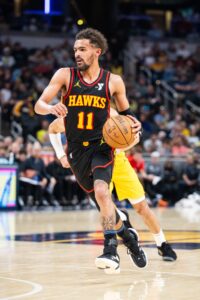 Trae Young ($43,031,940)
Trae Young ($43,031,940)- Dejounte Murray ($25,499,599)
- Murray’s cap hit includes a $24,799,600 base salary and $699,999 in likely incentives.
- Clint Capela ($22,265,280)
- De’Andre Hunter ($21,696,429)
- Bogdan Bogdanovic ($17,260,000)
- Onyeka Okongwu ($14,000,000)
- Jalen Johnson ($4,510,905)
- Kobe Bufkin ($4,299,000)
- AJ Griffin ($3,889,920)
- Mouhamed Gueye ($1,891,857)
- Total: $158,344,930
Non-Guaranteed Salary
- Bruno Fernando ($2,717,391)
- Fernando’s salary will become guaranteed if he remains under contract through June 29.
- Total: $2,717,391
Dead/Retained Salary
- None
Player Options
- None
Team Options
- Garrison Mathews ($2,230,253): Bird rights
- If his option is exercised, Mathews’ salary would remain non-guaranteed until June 29.
- Total: $2,230,253
Restricted Free Agents
- Saddiq Bey ($8,486,620 qualifying offer / $13,670,949 cap hold): Bird rights
- Total (cap holds): $13,670,949
Two-Way Free Agents
Note: Because he is no longer eligible to sign a two-way contract, Windler’s qualifying offer would be worth the minimum salary for a player with five years of NBA experience (projected to be $2,432,511). It would include a small partial guarantee.
Draft Picks
- No. 1 overall pick ($12,605,760 cap hold)
- Total (cap holds): $12,605,760
Extension-Eligible Players
- Clint Capela (veteran)
- Bruno Fernando (veteran)
- Extension-eligible as of October 2.
- Jalen Johnson (rookie scale)
- Garrison Mathews (veteran)
- Extension-eligible until June 30 (or beyond, if his team option is exercised).
- Trae Young (veteran)
Note: Unless otherwise indicated, these players are eligible for extensions beginning in July.
Unrestricted Free Agents
- Trent Forrest ($2,093,637 cap hold): Early Bird rights
- Wesley Matthews ($2,093,637 cap hold): Non-Bird rights
- Total (cap holds): $4,187,274
Cap Exceptions Available
Note: The Hawks project to operate over the cap and over the first tax apron. If they move below the first apron, they would gain access to the bi-annual exception ($4,681,000) and the full mid-level exception ($12,859,000) instead of the taxpayer mid-level exception and would regain access to their three trade exceptions (the largest of which is worth $23,019,560 and expires on July 8).
- Taxpayer mid-level exception: $5,183,000
Luke Adams contributed to this post.

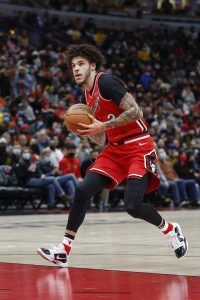 Whether or not Ball is able to return to action this fall, three knee surgeries and two-and-a-half seasons later, his presence won’t turn a team that has been unable to play .500 ball without him into a legitimate contender.
Whether or not Ball is able to return to action this fall, three knee surgeries and two-and-a-half seasons later, his presence won’t turn a team that has been unable to play .500 ball without him into a legitimate contender.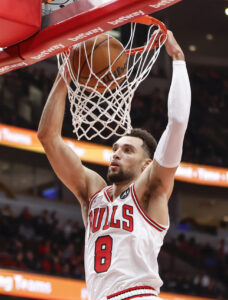
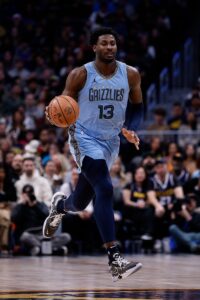 Memphis experimented with using Jackson more at center in ’23/24, with mixed results. Having him more involved in pick-and-rolls defensively meant he couldn’t be a weak-side roamer, which is what he’s best at. He can also be overpowered by bigger centers and is a subpar rebounder for a big man.
Memphis experimented with using Jackson more at center in ’23/24, with mixed results. Having him more involved in pick-and-rolls defensively meant he couldn’t be a weak-side roamer, which is what he’s best at. He can also be overpowered by bigger centers and is a subpar rebounder for a big man.


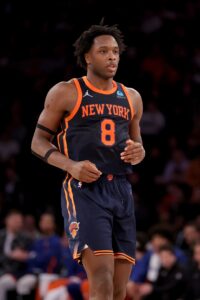 Let’s say the Knicks want to sign-and-trade
Let’s say the Knicks want to sign-and-trade  Of those three potential paths for Utah, I consider the safe, middle-of-the-road route (building through the draft, developing their young players, and hanging onto Markkanen) to be the likeliest, even if it won’t necessarily line the team up to draft a future star in 2025. I don’t think a Markkanen trade should be ruled out, whereas I view a blockbuster trade that accelerates the rebuild as an extreme long shot.
Of those three potential paths for Utah, I consider the safe, middle-of-the-road route (building through the draft, developing their young players, and hanging onto Markkanen) to be the likeliest, even if it won’t necessarily line the team up to draft a future star in 2025. I don’t think a Markkanen trade should be ruled out, whereas I view a blockbuster trade that accelerates the rebuild as an extreme long shot.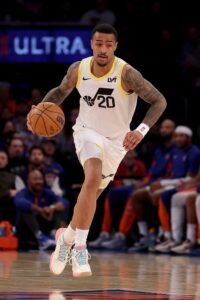
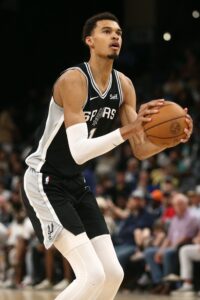 There has never been a player as tall and long as Wembanyama (he’s 7’4″ with a 8’0″ wingspan) who comes close to his unique blend of physical attributes and skills. While many seven-footers look stiff and awkward on the court due to their immense size, Wembanyama is agile, fluid and graceful, with excellent body control. He has a rare ability to precisely understand how his body can navigate a given space.
There has never been a player as tall and long as Wembanyama (he’s 7’4″ with a 8’0″ wingspan) who comes close to his unique blend of physical attributes and skills. While many seven-footers look stiff and awkward on the court due to their immense size, Wembanyama is agile, fluid and graceful, with excellent body control. He has a rare ability to precisely understand how his body can navigate a given space. Devin Vassell
Devin Vassell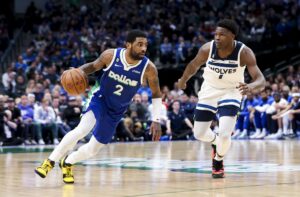 All the pieces came together in Minnesota during the Wolves’ second year with Gobert, as the team got off to a 17-4 start and held a top-three seed in the West for nearly the entire season, led by rising superstar
All the pieces came together in Minnesota during the Wolves’ second year with Gobert, as the team got off to a 17-4 start and held a top-three seed in the West for nearly the entire season, led by rising superstar 

 Teams can only beat the opponents in front of them, so I’m not here to run down either of the East’s two clubs left standing. But if the two teams avoid injuries going forward, this series will represent a new challenge for the Celtics and Pacers.
Teams can only beat the opponents in front of them, so I’m not here to run down either of the East’s two clubs left standing. But if the two teams avoid injuries going forward, this series will represent a new challenge for the Celtics and Pacers.